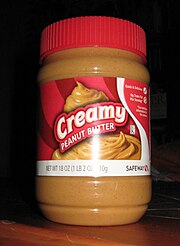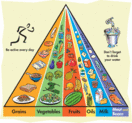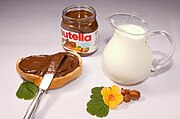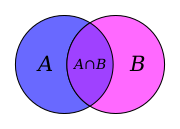Diferencia entre revisiones de «Niebla el gusanito»
m (→Lesson plan) |
(Caille the Caterpillar) |
||
| Línea 82: | Línea 82: | ||
# Doing the oils group as a larger group rather than as individuals might be beneficial since it is a tougher food group. | # Doing the oils group as a larger group rather than as individuals might be beneficial since it is a tougher food group. | ||
# This can be adapted so that each student has their own food pyramid or a whole class can share one large food pyramid. | # This can be adapted so that each student has their own food pyramid or a whole class can share one large food pyramid. | ||
| + | [[en:Caille the Caterpillar]] | ||
Revisión de 11:09 23 dic 2012
Contenido
- 1 Niebla el gusanito
- 1.1 worthiness
- 1.2 contenidos de la biologia
- 1.3 Materiales
- 1.4 Volantes
- 1.5 Descripción de la actividad
- 1.6 Lesson plan
- 1.7 Problemas potenciales
- 1.8 enlace con la Matemática
- 1.9 Y con Literatura
- 1.10 Connexiones con los estandares educacionales
- 1.11 Next steps
- 1.12 Citas y links
- 1.13 Reflexiones
- 1.14 If you read nothing else read this
Niebla el gusanito
worthiness
Probado y verificado Trusted
contenidos de la biologia
- Nutrición
- Piramide de los alimentos
- Herbivoría
- Ciclo de vida de los insectos
Materiales
Teacher: Caterpillar - de papel crepe (puede agregar, EX: ojos, antenas). Necesita bolsas plásticas for holding the cut out pieces of food. Una piramide actualizada. Pedazos grandes de papel Large piece of easel paper with a pyramid drawn on it split into 6 sections.
Studentes: Magazines, tijeras, cinta.
Volantes
Piramide de alimentos - Find an appropriate and updated version and back it with construction paper.
a la diestra, is a picture Niebla, the caterpillar that you can make.
Descripción de la actividad
The purpose of this activity is to bring the food pyramid to life. Hang the caterpillar up in a place that is visible to all students and pass out the hand out. Break the class into six groups and assign each group a food category. Ask them to go through the magazines and find foods that fall in their assigned category and cut out the pictures. After about 10 minutes call the class back together. Each child is to pick one of the pictures that they choose to share with the class. Go around the circle and give each child a chance to explain why they cut out the picture they choose and then have them place it into the caterpillars mouth.
Lesson plan
- Haga un gusanito en papel Kraft o de cualquier material que tengas. Asegurese que hagas la boca suficientemente grande para ubicar un bolsa ziplock a la espalda de tal modo que los estudiantes puedan poner alimentos en la boca de gusanito Niebla.
- Ya en la clase, comience una introducción simple sobre la piramide de alimentos. Asegurese que cubra los diferentes grupos de alimentos and what type of foods are in each.
- Luego, divida el grupo en seis y asigne un grupo de alimento a cada uno.
- Hand out magazines and scissors to each of the groups and ask them to flip through the magazines and ask each student to choose one food that they like from their assigned food group to feed to Caille the Caterpillar.
- Once each student has cut out his or her food, regroup with the entire class and ask each student to share their food choice and why they have chosen it.
- Have each student place his or her food choice into Caille's mouth.
- Then have the student tape their foods to the corresponding section on the easel food pyramid to make a poster for the classroom.
- You could conclude the lesson by reading a story such as The Very Hungry Caterpillar, by Eric Carle.
Tips:
- Be sure to cut the hole in the mouth of the caterpillar large enough for your students hands to fit in and out. This avoids some hassle trying to pull their hand out.
- You could begin the lesson with the story so that the students can make the connection with Caillie or it may be nice to read the book after they are finished otherwise younger grades especially will be too distracted.
Problemas potenciales
Algunos problemas que peuden surgir incluyen la dificultad de los estudiantes para identificar entre grupos de alimentos that you may come across may include student difficulty distinguishing between food group categories and running out of magazines to cut up. A way that this can be solved, is asking the students why they think that the food they chose is part of a specific food group. Finding good examples of oils also may become problematic or hard to explain. Oils may be harder to find, but you can explain to students what kinds of food are make of certain oils.
explicar los aceites
enlace con la Matemática
Los alumnos pueden hacer diagramas de Venn para mostrar los alimentos y sus bondades, que alimentos son chatarra y al medio cuales son ambiguos. Les permitirá disitinguir que alimentos son buenos poara su salud. Y para explorar los grupos de alimentos. Alimentos cocidos ocuparán las intersecciones... This will be good for the students to know what kinds of foods are healthy for them. Venn diagrams can also be used to explore food groups. Cooked foods will often occupy the intersections depending on what food groups are in a particular list of ingredients.
Y con Literatura
Lea "The Very Hungry Caterpillar," de Eric Carle. This way the children can focus in on the food that is talked about in the book and figure out what food groups they belong in.
Another book that relates to healthy eating is Gregory, the "Terrible Eater," by Mitchell Sharmat.
Connexiones con los estandares educacionales
This lesson can be applied to the Healthy Choices Standard for K-4 grade, as well as a math connection. 3.5 Students make informed, healthy choices that positively affect the health, safety, and well-being of themselves and others. This is evident when students: Can identify and classify foods according to the Food Guide Pyramid.
Next steps
Once this activity has been completed then the class could move on to talk about serving and serving sizes. You could also talk about vitamins and minerals found in different foods and why they are important for our bodies. You could also do a lesson and activity incorporating the importance of exercise.
Citas y links
Carle, Eric. The Very Hungry Caterpillar. (1994).
Reflexiones
When we tested this lesson on our group of second graders we found that starting with the book was more effective. If we could add something to it though it would have been nice to have a butterfly also. That way, once we fed our Caille the caterpillar all of the healthy foods, we could transform her into a beautiful butterfly. We also learned very quickly not to give the students materials before they needed them. For instance, in one group we had already passed out all of the materials for the students to cut out their health foods and rather than listening to one of us read the book, one student decided to cut up her food pyramid hand out. So if you do decided to read the book first, it is important to take everything one small step at a time.
Another important piece of this that we noticed was that many of the students had already heard the story The Very Hungry Caterpillar. Although the caterpillar is a central part of the lesson it may be beneficial to find other book about eating healthy and using the character from that book such as Gregory the Goat. This may be beneficial because while we were reading the story to the students many of them were distracted and their minds were definitely wondering where as if they are having a new storyline introduced to them they may have payed more attention to the story. Finally, we noticed that the section on the pyramid for oils was not only difficult to explain to the students, but very difficult to find in the magazines. One of the best examples we could find was vegetable oil or olive oil, but even those were a stretch to find because they were only in the list of ingredients, not an actual picture.
If you read nothing else read this
Important notes about this lesson:
- La boca de Niebla debe ser de un tamaño para que quepa en tu mano.
- Reading the story first is best so that students can begin making connections between the story and their task as they cut out the foods.
- Allot about a half an hour for this lesson.
- Doing the oils group as a larger group rather than as individuals might be beneficial since it is a tougher food group.
- This can be adapted so that each student has their own food pyramid or a whole class can share one large food pyramid.




